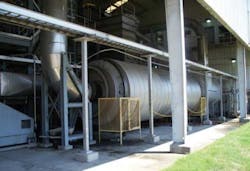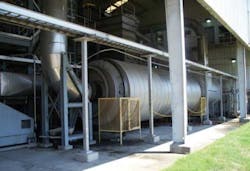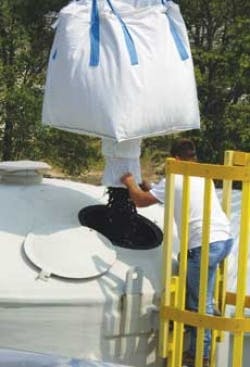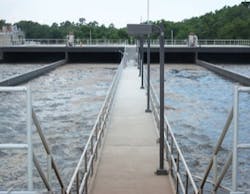Turnkey Treatment System Tackles Food-Processing Wastewater
In the fall of 2004, Mizkan Americas’ production facility in Crossville, TN, was mandated by the local authorities to pre-treat its wastewater for the reduction of BOD and TSS to less than 1,000 mg/L. As a result, John Prahler, Director of Corporate Engineering for Mizkan Americas, conducted an in-depth study to identify compact biological wastewater treatment systems that were easy to operate, required minimal maintenance, and were capable of handling fluctuating load conditions.
Mizkan Americas produces a variety of mustard and vinegar products generating a wastewater stream that is loaded with organics from multiple production campaigns ranging in flow from 10,000 to 20,000 gpd. Organic loads range from 1,000 mg/L to 10,000 mg/L TBOD and the wastewater is very acidic with a nominal pH range of 3.0 – 5.0 S.U.
In addition, rainwater run-off is retained and collected from the secondarily contained production tank farm. During low rainfall events, this wastewater can be heavily loaded with organics from spills within the containment area. Run-off water can also account for large volumes of wastewater over the course of an extended rainfall event. Based on Mizkan’s permit, this run-off must also be collected and treated within the wastewater pre-treatment system.
Mizkan Americas Wastewater Treatment Plant nearing completion.
The company’s wastewater also has total suspended solids (TSS) ranging from 100 mg/L to 3,000 mg/L and is loaded with mustard seeds and bottle caps from the production floor wash down operations.
Treatment System
To treat the wastewater, Mizken selected a custom designed ActiveCell™ biological wastewater treatment system from Headworks (previously Hydroxyl Systems). The system was designed using MediaPro™ software with data collected from the Mizkan facility over a three month period to account for all of the mustard and vinegar product campaigns. This also allowed the design to factor peak flow data during extensive rainfall events.
Since the ActiveCell wastewater treatment facility was to include a properly sized and designed equalization (EQ) tank, the fluctuating loads and flows would be dampened and buffered by the collection and homogenization of incoming wastewater with the wastewater retained in the EQ tank. The EQ tank would always retain a wastewater that accounts for a tank volume of 25-30% for buffering purposes.
The process uses thousands of suspended biofilm carriers (Headworks BIOcarriers™) that are continuously mixed within the tanks.
The pH of the wastewater collected in the EQ tank would be adjusted using caustic soda and mechanical agitation to an average pH of 7.0 to 7.5 S.U. prior to biological treatment. Therefore, Headworks was able to design the treatment system for average load conditions rather than peak load conditions, reducing the size of the biological reactors, minimizing system footprint and lowering the overall cost of the turnkey facility.
Treatment Process
The wastewater generated by the production facility is collected in screened troughs and flows by gravity into a below-grade lift station. It is then pumped to the wastewater treatment system via a set of vertical centrifugal pumps operating on a lead-lag basis. The wastewater is then fine-screened to less than 1 mm by a self cleaning rotary screen for the removal of mustard seeds, bottle caps and other solid waste.
The equalization tank, sized for 100,000 gallons, is capable of collecting and buffering the wastewater stream and has additional storage capacity for rainfall events. The wastewater’s acidic pH is adjusted by controlled injection of caustic soda into a continuously operating circulation loop. Wastewater in the EQ tank is agitated by a submerged mechanical mixer. Once the target pH value has been satisfied, a control valve directs wastewater from the circulation loop to the two-stage bioreactor system at a controlled rate of 14 gpm. A magnetic flow meter controls the adjustment of the valve and provides a signal to a nutrient dosing system where ammonia and phosphorous are dosed into the feed stream along with a defoaming agent.
The process operates within two 15,000 gallon bioreactor tanks, biodegrading wastewater using thousands of suspended biofilm carriers that are continuously mixed within the tanks. Each biofilm carrier provides an active surface area sustaining heterotrophic and autotrophic bacteria within protected cells. This dynamic population of bacteria achieves high-rate biodegradation while also offering process resiliency and automated operation.
The first-stage ActiveCell bioreactor provides a BOD roughing process removing 50% -70% of the BOD. A dissolved oxygen sensor mounted within the effluent discharge screen helps control a VFD that powers the positive displacement blowers, maintaining DO at a predetermined set point of ~3 mg/L.
The second-stage bioreactor degrades remaining organics to less than the target effluent parameters of <1,000 mg/L sBOD. Dead bacteria are continuously sloughed from the biofilm carriers and exit the bioreactors via a wedge wire retaining screen as TSS with the treated effluent. This continuous sloughing action exposes the biofilm to the organic load in the wastewater and provides a self-regulated high-rate biological treatment process that is responsive to load fluctuations.
The treated wastewater then flows by gravity to a dissolved air flotation (DAF) system located in a climate controlled process control building where total suspended solids are removed from the process stream. The solids accumulate on the surface of the water within the DAF, and a mechanical flight and chain assembly slowly skims the surface of the water to a sludge holding chamber. The treated and clarified wastewater is then collected in a lift station and pumped to the sewer drain for effluent discharge to the City of Crossville Wastewater Treatment Plant, meeting the target effluent quality standards of <1,000 mg/L BOD and <1,000 mg/L TSS.
The wastewater treatment system is fully automatic. Pictured is a view of the control panel interface.
A recirculation loop gives Mizkan the capability of multi-pass processing if a highly loaded slug of wastewater is received that requires additional retention and treatment to meet target effluent requirements, or to multi-pass the wastewater stream during low organic loading conditions during weekends and facility shutdown events.
“We were looking for a wastewater treatment solution that would handle high and fluctuating organic loads. We also wanted it to be easy to operate and maintain. The Activecell system has proven to be the solution we were looking for,” Prahler said.
About Mizkan Americas: Mizkan Americas, formerly Nakano Foods, is a subsidiary of Mizkan Group and has a heritage in the condiment business that spans 200 years. The company operates 14 plants in the United States providing vinegars, mustards, cooking wines, wine reductions, marinades, barbeque sauces and other condiments to the retail foodservice, specialty, Asian and industrial trade channels.
About Headworks Bio Inc.: Headworks Bio offers biological wastewater treatment processes, advanced oxidation processes, and shipboard marine wastewater treatment process products and technologies. For more information on the company and its products for the wastewater treatment industry, visit www.headworksusa.com.



